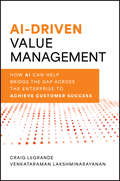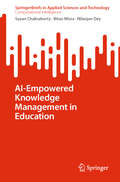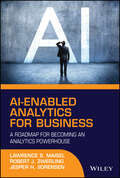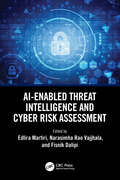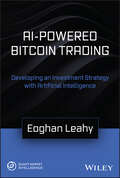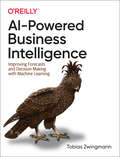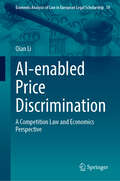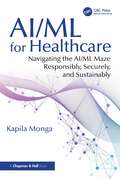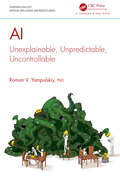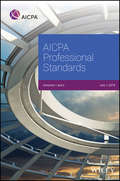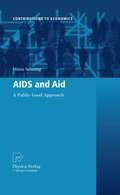- Table View
- List View
AI-Driven Value Management: How AI Can Help Bridge the Gap Across the Enterprise to Achieve Customer Success
by Craig LeGrande Venky LakshminarayananUnlock the power of generative AI to transform your enterprise B2B sales and marketing strategies In AI-Driven Value Management: How AI Can Help Bridge the Gap Across the Enterprise to Achieve Customer Success, authors Craig LeGrande and Venky Lakshminarayanan reveal how artificial intelligence can revolutionize B2B value management. This book lays out a first-ever strategic blueprint for cost-effectively scaling value management programs. Value management is the art and science of orchestrating all the business functions in your company to envision and create exceptional value for your customers – and in the process enhance your pipeline, revenue and renewals. It's designed for business leaders who are looking to harness AI to gain a competitive edge and boost pipeline, revenue and expansions, effectively solving the problem of expensive scaling in business-to-business sales and marketing. Dive into the core of AI-empowered Value Management (AI-VM) through a detailed exploration of a comprehensive AI-driven value management blueprint. This guide uses real-world success stories and cutting edge AI technology solutions to illustrate how businesses can combine people, processes, and technology to execute value management at scale, enhancing efficiency and effectiveness. In this book, you'll: Learn from the successes and strategies of leading companies like Salesforce, ServiceNow, and Amazon Web Services Discover the AI-VM Blueprint, an integrated framework that lays out strategic, operational, and technological guidelines for deploying AI-driven value management Equip your team with actionable insights and tools to innovate and implement AI in your sales, marketing and customer success strategies effectively AI-Driven Value Management is essential reading for B2B professionals eager to leverage AI for business growth. If you are a business leader, manager, or professional aiming to integrate AI into your value management practices, this book will provide you with the knowledge and tools you need.
AI-Empowered Knowledge Management in Education (SpringerBriefs in Applied Sciences and Technology)
by Nilanjan Dey Sayan Chakraborty Bitan MisraThis book explains basic ideas behind several methods used in artificial intelligence-based knowledge management techniques. It also shows how these techniques are applied in practical contexts in different education sectors. The book discusses AI-based knowledge management applications, AI-empowered knowledge management in primary and higher education, and technical and ethical challenges and opportunities.
AI-Enabled Analytics for Business: A Roadmap for Becoming an Analytics Powerhouse
by Lawrence S. Maisel Robert J. Zwerling Jesper H. SorensenWe are entering the era of digital transformation where human and artificial intelligence (AI) work hand in hand to achieve data driven performance. Today, more than ever, businesses are expected to possess the talent, tools, processes, and capabilities to enable their organizations to implement and utilize continuous analysis of past business performance and events to gain forward-looking insight to drive business decisions and actions. AI-Enabled Analytics in Business is your Roadmap to meet this essential business capability. To ensure we can plan for the future vs react to the future when it arrives, we need to develop and deploy a toolbox of tools, techniques, and effective processes to reveal forward-looking unbiased insights that help us understand significant patterns, relationships, and trends. This book promotes clarity to enable you to make better decisions from insights about the future. Learn how advanced analytics ensures that your people have the right information at the right time to gain critical insights and performance opportunities Empower better, smarter decision making by implementing AI-enabled analytics decision support tools Uncover patterns and insights in data, and discover facts about your business that will unlock greater performance Gain inspiration from practical examples and use cases showing how to move your business toward AI-Enabled decision making AI-Enabled Analytics in Business is a must-have practical resource for directors, officers, and executives across various functional disciplines who seek increased business performance and valuation.
AI-Enabled Threat Intelligence and Cyber Risk Assessment
by Narasimha Rao Vajjhala Edlira Martiri Fisnik DalipiAI-Enabled Threat Intelligence and Cyber Risk Assessment delves into the transformative potential of artificial intelligence (AI) in revolutionizing cybersecurity, offering a comprehensive exploration of current trends, challenges, and future possibilities in mitigating cyber risks. This book brings together cutting-edge research and practical insights from an international team of experts to examine how AI technologies are reshaping threat intelligence, safeguarding data, and driving digital transformation across industries. The book covers a broad spectrum of topics, including AI-driven fraud prevention in digital marketing, strategies for building customer trust through data privacy, and the role of AI in enhancing educational and healthcare cybersecurity systems. Through in-depth analyses and case studies, this book highlights the barriers to AI adoption, the legal and ethical considerations, and the development of resilient cybersecurity frameworks.Special emphasis is given to regional insights, such as the digital transformation of Kazakh businesses and the integration of AI in diverse global contexts, offering valuable lessons for researchers, policymakers, and practitioners. From safeguarding patient data in healthcare to addressing automated threats in digital marketing, this book provides actionable strategies and emerging perspectives on the evolving landscape of AI in risk management. Designed for academics, professionals, and students, AI-Enabled Threat Intelligence and Cyber Risk Assessment serves as an essential resource for understanding the intersection of AI, cybersecurity, and risk assessment. With contributions from leading researchers across various disciplines, this book underscores the critical role of AI in building resilient, ethical, and innovative solutions to today’s most pressing cybersecurity challenges.
AI-First Healthcare
by Kerrie L. Holley Siupo BeckerAI is poised to transform every aspect of healthcare, including the way we manage personal health, from customer experience and clinical care to healthcare cost reductions. This practical book is one of the first to describe present and future use cases where AI can help solve pernicious healthcare problems.Kerrie Holley and Siupo Becker provide guidance to help informatics and healthcare leadership create AI strategy and implementation plans for healthcare. With this book, business stakeholders and practitioners will be able to build knowledge, a roadmap, and the confidence to support AIin their organizations—without getting into the weeds of algorithms or open source frameworks.Cowritten by an AI technologist and a medical doctor who leverages AI to solve healthcare’s most difficult challenges, this book covers:The myths and realities of AI, now and in the futureHuman-centered AI: what it is and how to make it possibleUsing various AI technologies to go beyond precision medicineHow to deliver patient care using the IoT and ambient computing with AIHow AI can help reduce waste in healthcareAI strategy and how to identify high-priority AI application
AI-ML for Decision and Risk Analysis: Challenges and Opportunities for Normative Decision Theory (International Series in Operations Research & Management Science #345)
by Louis Anthony Cox Jr.This book explains and illustrates recent developments and advances in decision-making and risk analysis. It demonstrates how artificial intelligence (AI) and machine learning (ML) have not only benefitted from classical decision analysis concepts such as expected utility maximization but have also contributed to making normative decision theory more useful by forcing it to confront realistic complexities. These include skill acquisition, uncertain and time-consuming implementation of intended actions, open-world uncertainties about what might happen next and what consequences actions can have, and learning to cope effectively with uncertain and changing environments. The result is a more robust and implementable technology for AI/ML-assisted decision-making.The book is intended to inform a wide audience in related applied areas and to provide a fun and stimulating resource for students, researchers, and academics in data science and AI-ML, decision analysis, and other closely linked academic fields. It will also appeal to managers, analysts, decision-makers, and policymakers in financial, health and safety, environmental, business, engineering, and security risk management.
AI-Powered Bitcoin Trading: Developing an Investment Strategy with Artificial Intelligence
by Eoghan LeahySurvive and thrive amongst the professional traders using sophisticated cryptocurrency analysis and trading techniques The purpose of this book is to provide a concise yet comprehensive background of some effective methods for analyzing markets and creating fully automated AI-optimized trading systems. The book outlines some easy-to-replicate yet highly effective quant trading techniques that can be used for analyzing asset prices and then apply them to Bitcoin prices, showing how to generate actionable insights from data that can be used to create fully automated trading signals and systems. Big data analytics can be enhanced with artificial intelligence techniques. Back testing and optimization methods are presented with a special emphasis placed on the use of distributed genetic algorithms for parameter optimization. Finally, a case study of a fully automated trend-following trading strategy that leverages artificial intelligence is presented. Bitcoin AlphaBot™ combines human insight with AI-driven optimization to build profit table trend trading strategies.
AI-Powered Business Intelligence: Improving Forecasts and Decision Making with Machine Learning
by Tobias ZwingmannUse business intelligence to power corporate growth, increase efficiency, and improve corporate decision making. With this practical book featuring hands-on examples in Power BI with basic Python and R code, you'll explore the most relevant AI use cases for BI, including improved forecasting, automated classification, and AI-powered recommendations. And you'll learn how to draw insights from unstructured data sources like text, document, and image files.Author Tobias Zwingmann helps BI professionals, business analysts, and data analytics understand high-impact areas of artificial intelligence. You'll learn how to leverage popular AI-as-a-service and AutoML platforms to ship enterprise-grade proofs of concept without the help of software engineers or data scientists.Learn how AI can generate business impact in BI environmentsUse AutoML for automated classification and improved forecastingImplement recommendation services to support decision-makingDraw insights from text data at scale with NLP servicesExtract information from documents and images with computer vision servicesBuild interactive user frontends for AI-powered dashboard prototypesImplement an end-to-end case study for building an AI-powered customer analytics dashboard
AI-empowered Knowledge Management (Studies in Big Data #107)
by Nilanjan Dey Soumi MajumderThis book is focused on AI-empowered knowledge management to improve processes, implementation of technology for providing easy access to knowledge and the impact of knowledge management to promote the platform for generation of new knowledge through continuous learning. The book discusses process of knowledge management which includes entirety of the creation, distribution, and maintenance of knowledge to achieve organizational objectives. It also covers knowledge management tools which enable and enhance knowledge creation, codification, and transfer within business firms thereby reducing the burden of work and allowing application of resources and effective usage towards practical tasks. An immense growth of artificial intelligence in business organizations has occurred and AI-empowered knowledge management practice is leading towards growth and development of the organization.
AI-enabled Price Discrimination: A Competition Law and Economics Perspective (Economic Analysis of Law in European Legal Scholarship #18)
by Qian LiThis book addresses the question of how to tackle AI-enabled price discrimination (AIPD), which is commonly used in digital markets and can negatively impact competition and consumers. It explores the economic rationale behind AIPD, compares its assessment under EU and Chinese competition law and beyond, evaluates current legal regimes on AIPD from a comparative law and economics perspective, and provides policy recommendations to those jurisdictions for approaching AIPD as an infringement of competition law and beyond. Since the protection of free competition and consumer welfare are objectives of competition law in both the EU and China, two major jurisdictions, there seems to be a legal basis for competition law intervention. This book offers competition authorities guidance on how to tackle anticompetitive AIPD. Given that AIPD takes place in competitive and monopolistic markets, competition law alone is inadequate to fully address the potential concerns. This book, therefore, also examines other possibilities. Legislation on data protection, consumer protection and business regulation can contribute to tackling AIPD in different phases: (1) collection and processing of consumer data, (2) prediction of the consumer’s willingness to pay, and (3) application of discriminatory pricing in digital markets. As such, this work also offers insights to help the relevant authorities (i.e., those responsible for data protection, consumer protection and business regulation) tackle welfare-reducing AIPD in digital markets. This book will be of interest to academics, practitioners, policymakers, enforcers and consumers. It offers theoretical guidance for the relevant authorities (such as competition agencies, courts and regulators), practitioners and consumers, helping them understand the economic rationale behind AIPD, and provides suggestions to tackle anticompetitive and welfare-reducing AIPD in digital markets from a comparative law and economics perspective.
AI/ML for Healthcare: Navigating the AI/ML Maze Responsibly, Securely, and Sustainably
by Kapila MongaThe advent of Generative AI has democratized access to AI, prompting nearly everyone in healthcare organizations - from frontline workers to business leaders – to ask pressing questions: How can I be better equipped to support AI adoption meaningfully? How do I ensure I ask the right questions? What cautions should I exercise as I think about AI/machine learning (ML) in my business process? This book aims to answer these and other such questions and to empower healthcare professionals, at all levels, by providing them knowledge across various aspects of AI/ML, enabling them (at least in part) to realize positive, lasting business value from AI and ML initiatives. This book draws upon my experience of working in healthcare AI/ML, lessons I learned while observing leaders in this space trying to make a difference, and research (for evolving topics like sustainable AI development and securing AI/ML systems).This book provides readers with actionable insights to build responsible, secure, and sustainable AI/ML solutions in healthcare and delves into key principles for scaling AI/ML value delivery, including establishing Machine Learning Operations (MLOps) processes and launching citizen data science programs. At its heart, this book features a healthcare-specific case study that bridges the gap between theoretical knowledge and practical application, illustrating all major concepts in a real-world context.The final chapter of this book offers a forward-looking commentary on the future of healthcare AI/ML. It explores the potential of Generative AI for healthcare and advocates leveraging lessons from past AI/ML implementations to chart a meaningful path for embracing Generative AI. Additionally, this book emphasizes the importance of adopting “reciprocal altruism” to accelerate AI/ML value realization across the healthcare industry and provides practical recommendations toward the same.
AI: Unexplainable, Unpredictable, Uncontrollable (Chapman & Hall/CRC Artificial Intelligence and Robotics Series)
by Roman V. YampolskiyDelving into the deeply enigmatic nature of Artificial Intelligence (AI), AI: Unexplainable, Unpredictable, Uncontrollable explores the various reasons why the field is so challenging. Written by one of the founders of the field of AI safety, this book addresses some of the most fascinating questions facing humanity, including the nature of intelligence, consciousness, values and knowledge.Moving from a broad introduction to the core problems, such as the unpredictability of AI outcomes or the difficulty in explaining AI decisions, this book arrives at more complex questions of ownership and control, conducting an in-depth analysis of potential hazards and unintentional consequences. The book then concludes with philosophical and existential considerations, probing into questions of AI personhood, consciousness, and the distinction between human intelligence and artificial general intelligence (AGI).Bridging the gap between technical intricacies and philosophical musings, AI: Unexplainable, Unpredictable, Uncontrollable appeals to both AI experts and enthusiasts looking for a comprehensive understanding of the field, whilst also being written for a general audience with minimal technical jargon.
AIC Netbooks: Optimizing Product Assembly
by Steven C. Wheelwright Sunru YongAIC Systems, located in Taichung, Taiwan, is a manufacturer of printed circuit boards, primarily for motherboards and video cards for personal computers. The firm is considered an original design manufacturer (ODM) and takes an active role in innovating and designing each new generation of components. By doing in-house design and development, the company has been able to foster exclusive, long-term relationships with its customers. The firm decides to diversify its portfolio to include consumer electronics with a particular focus on mobile technology. The goal is to move from manufacturing components for other computer companies to developing the firm's own line of branded consumer electronics. The new "netbook" market provides an opportunity for AIC Systems to design and manufacture a branded product in the mobile electronics industry. The production manager has created an assembly line for producing the new netbooks, and after three months of production he must consider ways to improve efficiency and reduce production costs. Students must perform a quantitative analysis of the existing assembly-line system and make recommendations to reach optimal efficiency.
AICPA Professional Standards 2019, Volumes 1 and 2: Cch#04585404 (AICPA)
by AICPAUpdated as of July 1, 2019, this two-volume set is a comprehensive source of professional standards and interpretations issued by the AICPA, such as auditing and attestation, accounting and review services pronouncements, along with the AICPA Code of Professional Conduct and Bylaws. Standards and related interpretations, to help you apply the standards in specific circumstances, are arranged by subject with amendments noted, superseded portions deleted, and conforming changes reflected. New to this edition: Statement on Auditing Standards (SAS) No. 134, Auditor Reporting and Amendments, Including Amendments Addressing Disclosures in the Audit of Financial Statements SAS No. 135, Omnibus Statement on Auditing Standards—2019 SAS No. 136, Forming an Opinion and Reporting on Financial Statements of Employee Benefit Plans Subject to ERISA SAS No. 137, The Auditor's Responsibilities Relating to Other Information Included in Annual Reports Statement on Standards for Forensic Services No. 1, Statement on Standards for Forensic Services
AIDS and Aid: A Public Good Approach (Contributions to Economics)
by Diana SonntagThe emerging outlook on the AIDS crisis is bleak; it seems that Millennium Development Goal 6 cannot be achieved in most developing countries by 2015. While most books look at the HIV/AIDS epidemic from an epidemiological point of view, this work evaluates AIDS and the international financing mechanisms of aid from a public good perspective. In contrast to the standard approach of the academic literature on AIDS, which derives policy recommendations from the demand side, this book explicitly considers the supply side. The study does not only advance the public goods literature, it also provides new insights into the effectiveness of international policies and paves the way for policy recommendations. As it reveals the weaknesses of current anti-HIV policies, a more effective allocation of international assistance is postulated.
AIDS and Business (Routledge Advances in Management and Business Studies #Vol. 41)
by Jean-Claude Usunier Saskia FaulkThe spread of HIV/AIDS affects businesses in all sectors, all industries and all countries. For companies and organizations everywhere, the question is no longer whether to take action on HIV/AIDS but which actions to take. Complete with an impressive collection of complex background and research on HIV/AIDS and a foreword by Dr. Peter Piot, former Executive Director of UNAIDS, this volume collects case studies of managers worldwide faced with challenging HIV/AIDS-related management decisions. AIDS and Business will fascinate the general reader seeking an understanding of the HIV/AIDS pandemic and to the advanced reader looking to develop a more sophisticated understanding of the impact of the disease. The case studies in this volume, set in nine countries, detail the issues facing businesses operating in areas where HIV/AIDS prevalence is growing. The topics discussed include understanding the role of social and cultural factors in the spread of HIV, the different organizations and institutions fighting the epidemic, designing an HIV communications campaign, HIV testing, ethical issues, marketing ethics and CSR, condoms marketing, and designing an HIV workplace program. Useful as a resource on HIV/AIDS and business, a set of case studies, or a training tool, this book contains a unique range of tools for learning to understand the epidemic, designed from a grounded and practical business perspective.
AIDS in Brazil
by Ricardo Reisen de Pinho Rohit DeshpandeAbbott Labs has reached an impasse with the Brazilian government in negotiations over the pricing of a new anti-AIDS drug, Kaletra. The Brazilian government threatens compulsory licensing unless Abbott drastically reduces the price of Kaletra.
AIG and the American Taxpayers (A)
by Karthik Ramanna Matthew ShafferExplores the decision faced by AIG's board on whether to join shareholder and ex-CEO Maurice Greenberg's lawsuit against the U.S. government. The suit, argued by super-lawyer David Boies (of Bush v. Gore and California gay marriage fame), claims that in September 2008 the U.S. arbitrarily set aside the rights of AIG's shareholders - violating the Fifth Amendment by taking private property without just compensation - while preserving shareholder rights in other troubled financial institutions, including Goldman Sachs whose ex-CEO was then Treasury Secretary. The U.S. government moves to dismiss the case arguing that it has wide discretion in times of crisis, but a federal judge allows the suit to proceed. The case raises two issues central to understanding capitalism: (1) the importance of and limits to property rights; and (2) the role of the state in choosing between varieties of capitalism, here between oligarchic and entrepreneurial capitalism.
AIGA Professional Practices in Graphic Design
by Tad Crawford"Provides definitive guidelines on all aspects of the graphic design business."-FYI. * Newly revised and expanded version of an industry classic--5,000 sold! * Up-to-the-minute! Includes web, interactive, and green design, new legislation * Each chapter written by an authority on the subject. Here's the definitive guide to professional business practices in graphic design, now fully revised and updated for the digital age. Up-to-the-minute coverage of web, interactive, and motion graphics; green design; potential repercussions of legislation on Orphan Works; protection of fonts and software; managing creative people; using professional help such as lawyers; and much more. Each in-depth chapter, covering such topics as professional relationships, fees, contracts, managing large projects, copyright and trademark issues, electronic uses, and more, has been written by an authority in the field. The newly revised AIGA Standard Form for Design Services is included for the convenience of readers, along with a complete resources section. No designer should do business without this comprehensive, authoritative book.
AIP Healthcare Japan: Investing in Japan's Retirement Home Market
by John A. Quelch Qing XiaThe CEO of a health care-based REIT is considering alternative nursing home investment strategies. Students must consider macro-industry trends, scale and scope issues and consumer segmentation data in making their recommendations.
AIP Healthcare Japan: Investing in Japan's Retirement Home Market
by John A. Quelch Qing XiaThe CEO of a health care-based REIT is considering alternative nursing home investment strategies. Students must consider macro-industry trends, scale and scope issues and consumer segmentation data in making their recommendations.
AKB48: Going Global? (A)
by Mayuka Yamazaki Juan Alcacer Kotaro Sasamoto Tee ChayakulAfter a remarkable success in Japan, the producer of the Japanese female singing group AKB48 evaluates market opportunities overseas for his artistic creation. This case introduces the business model behind the AKB48 concept and allows students to identify what geographic market - China, Indonesia, Taiwan, The Philippines, Thailand or South Korea - is more suitable for AKB48's first move overseas. During the discussion, students also identify the geographic limits of a product and what changes, if any, should be done to adapt it to a chosen market. Given high levels of piracy in the music industry, students are not only able to explore the value creation aspects of AKB48 but also the value capture features of its business model.
AKB48: Going Global? (A)
by Mayuka Yamazaki Juan Alcacer Kotaro Sasamoto Tee ChayakulAfter a remarkable success in Japan, the producer of the Japanese female singing group AKB48 evaluates market opportunities overseas for his artistic creation. This case introduces the business model behind the AKB48 concept and allows students to identify what geographic market - China, Indonesia, Taiwan, The Philippines, Thailand or South Korea - is more suitable for AKB48's first move overseas. During the discussion, students also identify the geographic limits of a product and what changes, if any, should be done to adapt it to a chosen market. Given high levels of piracy in the music industry, students are not only able to explore the value creation aspects of AKB48 but also the value capture features of its business model.
AKB48: Going Global? (B)
by Mayuka Yamazaki Juan AlcacerAfter a remarkable success in Japan, the producer of the Japanese female singing group AKB48 evaluates market opportunities overseas for his artistic creation. This case introduces the business model behind the AKB48 concept and allows students to identify what geographic market - China, Indonesia, Taiwan, The Philippines, Thailand or South Korea - is more suitable for AKB48's first move overseas. During the discussion, students also identify the geographic limits of a product and what changes, if any, should be done to adapt it to a chosen market. Given high levels of piracy in the music industry, students are not only able to explore the value creation aspects of AKB48 but also the value capture features of its business model.
ALAC International
by Richard S. Ruback Royce YudkoffALAC was a small importer of specialty industrial chemicals. The case explores the different financing alternatives to facilitate the company's explosive growth in working capital. At the end of 2009, the company was awarded the United States distributorship for the specialty chemical di-isononyl phthalate (DINP) from a large Taiwanese producer and had almost tripled its sales in 2010. It expected to double its sales in 2011 and to dramatically increase its profits. ALAC critically needed to obtain financing for the explosive growth in its inventory and accounts receivable balances.
